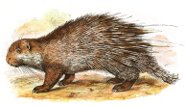 The thick-spined porcupine (Hystrix crassispinis) is also called the Bornean rattle porcupine. It is one of the few native mammals in Southeast Asia that is not endangered. This large rodent is often hunted by people for its meat. It lives in the forests, pastures and plantations of the Island of Borneo. It can survive in hilly regions up to 3937 feet (1200 meters) above sea level. It can even live in people’s back yards. Unlike many other native rodents, it seems unconcerned by the spread of man and his farmlands.
The thick-spined porcupine (Hystrix crassispinis) is also called the Bornean rattle porcupine. It is one of the few native mammals in Southeast Asia that is not endangered. This large rodent is often hunted by people for its meat. It lives in the forests, pastures and plantations of the Island of Borneo. It can survive in hilly regions up to 3937 feet (1200 meters) above sea level. It can even live in people’s back yards. Unlike many other native rodents, it seems unconcerned by the spread of man and his farmlands.They also do well in captivity, provided that they are kept in heated environments with a humidity level kept to at least 35%. Food must be given on the ground or in bowls hard enough to withstand the strong, nearly beaver-like teeth, which grow throughout the porcupine’s life. When they are not eating or gnawing, thick-spined porcupines like to tunnel underground.
Physical Description
Thick-spined porcupines resemble large small-toothed beavers with long toes and pale spines behind the forelegs, up to the middle of the back and down to the tail. Spines, more properly called quills, are modified hairs and made of the same material as hair. Their short fur is brown or grey with a pale underbelly, neck and insides of the legs. Some have small white patches on the body or face.
An adult thick-spined porcupine can grow to be 17 inches (43.18 centimeters) long. Quills can grow as long as 7 inches (17.78 centimeters.) Adults can weigh from 3.3 to 6.61 pounds (1.5 to 3 kilograms.) These quills can be raised or voluntarily rustled by the porcupine, making a hissing or rattling noise.
Life Cycle and Behavior
Much of thick-spined porcupine’s behavior is unknown because of their nocturnal lifestyle. Thick-spined porcupines tolerate being near each other, but tend to keep to just mated pairs and offspring. Males help protect babies, but the female does most of the work raising the young. The one to three babies produced stay with their parents from 6 months to one year before going off on their own.
Thick-spined porcupines sleep in underground burrows during the day and come up to feed at night. They eat fruits, vegetables, grains, roots, tubers, cereals and dry pet food. It is unknown what other predators feed on thick-spined porcupines other than people.
The Thick-spined porcupine is listed as Near Threatened (LR/nt), is close to qualifying for or is likely to qualify for a threatened category in the near future, on the IUCN Red List of Threatened Species
Namings for the thickspined porcupine
A young / baby of a thickspined porcupine is called a 'pup'. The females are called 'sow' and males 'boar'. A thickspined porcupine group is called a 'prickle or family'.
Custom Search